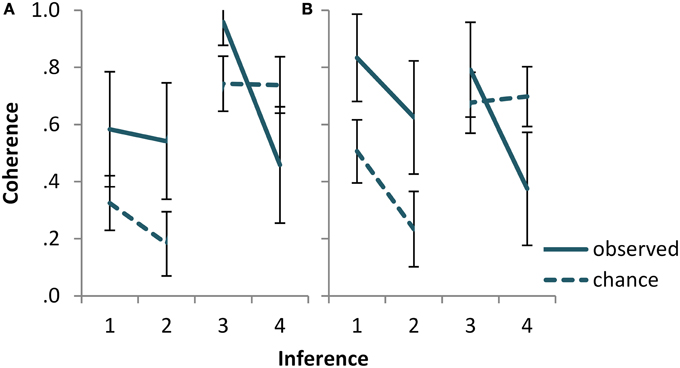Bayesian reasoning with ifs and ands and ors
- 1Department of Psychological Sciences, Birkbeck, University of London, London, UK
- 2Laboratory CHArt (PARIS), Université Paris 8, Paris, France
- 3Institut Jean Nicod, Paris, France
- 4Department of Psychology, Durham University, Durham, UK
A corrigendum on
Bayesian reasoning with ifs and ands and ors
by Cruz, N., Baratgin, J., Oaksford, M., and Over, D. E. (2015). Front. Psychol. 6:192. doi: 10.3389/fpsyg.2015.00192
In the article “Bayesian reasoning with ifs and ands and ors,” by Nicole Cruz, Jean Baratgin, Mike Oaksford, and David E. Over (Frontiers in Psychology, 2015, Vol. 6, Art. 192), on page 6, Figure 2, the x-axis in both panels would have to read “1, 2, 4, 3” in order to correctly represent the figure. Rearranging the figure to retain an x-axis labeling in ascending order, the corrected Figure 2 is displayed as follows.

Figure 2. Observed vs. chance coherence for the four inferences of Experiment2, (A) for the statements and (B) for the inferences task. Inferences 1 and 2 are and-to-if inferences. The first has the conjunction p and q as single premise, the second has p and q as two separate premises. Inferences 3 and 4 are and-elimination inferences. The first has prototypical, and the second counter-prototypical content for the scenario. See Table 1 for the precise logical form of the inferences. Error bars show 95% CI.
Conflict of Interest Statement
The authors declare that the research was conducted in the absence of any commercial or financial relationships that could be construed as a potential conflict of interest.
Keywords: uncertain reasoning, deduction, conditionals, coherence, conjunction fallacy
Citation: Cruz N, Baratgin J, Oaksford M and Over DE (2015) Corrigendum: Bayesian reasoning with ifs and ands and ors. Front. Psychol. 6:718. doi: 10.3389/fpsyg.2015.00718
Received: 13 May 2015; Accepted: 13 May 2015;
Published: 27 May 2015.
Edited by:
David R. Mandel, Toronto Research Centre, CanadaReviewed by:
Igor Douven, Paris-Sorbonne University, FranceCopyright © 2015 Cruz, Baratgin, Oaksford and Over. This is an open-access article distributed under the terms of the Creative Commons Attribution License (CC BY). The use, distribution or reproduction in other forums is permitted, provided the original author(s) or licensor are credited and that the original publication in this journal is cited, in accordance with accepted academic practice. No use, distribution or reproduction is permitted which does not comply with these terms.
*Correspondence: Nicole Cruz, ncruzd01@mail.bbk.ac.uk
 Nicole Cruz
Nicole Cruz Jean Baratgin
Jean Baratgin Mike Oaksford
Mike Oaksford David E. Over
David E. Over